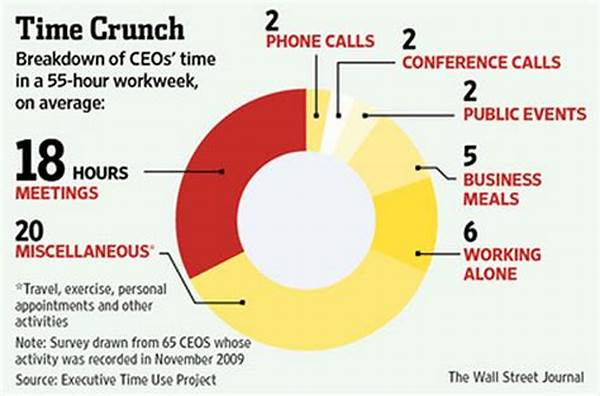It’s often said that time is money, and no one understands this better than CEOs. Their ability to structure a daily schedule effectively can make or break the businesses they lead. Have you ever wondered what a day in the life of these corporate wizards looks like? Are they merely high-flying executives sipping lattes in the boardroom, or is there more to their day than meets the eye? While the popular image of CEOs may evoke high-pressure conferences and important meetings—think of them as adrenaline-fueled marathons—the reality is both amusingly ordinary and spectacularly unique. So, how do CEOs structure their daily schedules to ensure their companies run like well-oiled machines? Let’s dive into this enigmatic world where humor, strategy, and data-driven decisions build the tapestry of their daily routines.
Read More : How To Build A Balanced Productivity Routine
While celebrity tabloids provide a glimpse into the lavish lives of CEOs during their off hours, their workdays often start before your alarm even thinks about ringing. A significant number of CEOs kickstart their mornings with physical exercise. Think of it as their secret weapon— a concoction of cardiovascular workouts and weight training designed to pump up their energy levels and prime their mindset for a productive day ahead. It’s not just about keeping in shape; it’s a strategic investment in their focus and discipline.
The next cornerstone of a CEO’s day is meetings. A lot of them. Now, don’t roll your eyes just yet. These are not your typical droning sessions where hope for productivity goes to die. No siree! CEOs adeptly curate their meetings to ensure that every participant has skin in the game, making the interaction as engaging as it is informative. But there’s more than just nuts-and-bolts here. Humor often finds a place, slicing through any potential monotony and ensuring that these power meetings are anything but a snooze fest.
The Importance of Delegation
Every CEO knows that while trying to do everything is a testament to their capability, it’s not a smart strategy. Enter delegation. This often-misunderstood art form is not just about lightening the load; it’s about empowering a team to reach its highest potential. How CEOs structure their daily schedules around this principle often involves setting time aside to meet and strategize with their key players, providing both direction and trust, which are invaluable currencies in leadership.
—
The logic behind a CEO’s structured schedule is derived from the simple fact that time is a finite resource, and maximizing its value is imperative for driving a company forward. But the sole purpose isn’t just squeezing productivity out of every second—it’s a multidimensional approach incorporating personal wellbeing, business prosperity, and leadership development.
A key aspect of this is the alignment of personal values with professional goals. How CEOs structure their daily schedules also revolves around time spent on personal development, be it through reading, mentoring, or even engaging with diverse experiences that foster their innovative spirits. The deeper their understanding, the more strategically they can steer their companies towards success.
Additionally, the blend of scheduled tasks and spontaneous creative sessions allows them to be both systematic and adaptable. When the day’s more predictable elements are juxtaposed with time reserved for creative exploration, CEOs remain not just reactive to market demands but proactive in innovation.
Strategic Structure: A View from the Top
Here’s where a CEO’s perspective diverges wildly from conventional routines. It’s not merely about meetings and emails. It’s about forecasting industry trends, navigating volatile markets, and making calls with significant repercussions. This is how CEOs structure their daily schedules to ensure that every decision builds towards long-term vision rather than short-term gain.
Emotional Resilience in Leadership
As much as it’s about intellectual strategy, it’s also about emotional resilience. Complex decision-making can be fraught with stress, which is why downtime—whether spent with family or indulging in personal passions—is non-negotiable. It’s these moments of genuine reprieve that recalibrate their inner compass, equipping them to face challenges head-on.
A CEO’s structured daily schedule is a marvel of modern leadership, encapsulating every element needed for steering a company to new heights. By digging into the meticulous planning and unique execution, we glean valuable lessons that extend far beyond the boardroom.
—
The art of crafting the ideal schedule can be boiled down into several elements, emphasizing both effectiveness and efficiency. Here’s a sneak peek at what makes a CEO’s daily agenda tick:
To wrap up, the complexity of a CEO’s schedule is a complex blend of art and science, weaving together strategy, personal wellbeing, and the drive to lead.
Designing Impactful Agendas
In crafting their schedules, CEOs create frameworks that promote not just individual success, but also collective advancement. The intricacies of how CEOs structure their daily schedules reveal a symphony of components seamlessly integrated to achieve brilliance. Whether juggling board meetings and brainstorming sessions or maintaining a work-life balance, the extent to which each executive customizes their routine underscores its personal and professional significance.
The Secret Sauce: Balance and Flexibility
It’s in the fine balance between rigidity and flexibility that CEOs find their groove. While some days may look as consistent as clockwork, others present opportunities for spontaneity and innovation. Both are critical in navigating the ever-evolving landscape of modern business. By diving into CEOs’ schedules, there’s much to learn about the finesse with which they steer their ships.
The world might see these leaders at the pinnacle of success, but the true marvel lies in how they craft and stick to their schedules, one that not only prioritizes business growth but also personal fulfillment.
—
The CEOs’ daily agenda is a testament to their roles as both captains of industry and stewards of balance. Their structured approaches reveal the transformative power of an artfully planned day. It’s a curious mix of must-dos, love-to-dos, and would-love-to-dos that altogether brings forward an equilibrium suited to fast-paced, high-stakes business environments.
Balancing this dance isn’t just about keeping up with demands—there is the allure of staying a step ahead. Instead of being swept along by the tide of tasks, CEOs grasp the helm to navigate their time as a critical asset to leverage for both business victories and personal satisfaction, painting a picture of leadership that inspires hope and ambition in equal measure.
—
Executing a perfectly curated schedule is an art mastered by some of the world’s top CEOs. Contrary to the one-size-fits-all approach, how CEOs structure their daily schedules varies dramatically and is as unique as their fingerprints. It speaks volumes about their leadership style, aligning their time with both the demands of their role and their personal ethics.
Perhaps the most intriguing aspect is the way these leaders anchor themselves in the tangible while allowing ample room for abstract thought. This mixture is critical as unforeseen challenges arise, turning their days into figurative minefields. Tackling such unpredictability with foresight and preparedness is a testament to their skilled time management, ensuring harmonious workdays where productivity thrives.
Navigating Dynamic Timelines
Time isn’t just passing minutes for a CEO; it’s an orchestrated asset demanding meticulous planning. Their calendars exemplify a careful choreography of precision and adaptability, striking a balance that allows room for flexibility.
The Balance Act: Purpose Meets Passion
The need to juggle various responsibilities demands that CEOs wear multiple hats throughout their schedule. Their daily structure might include everything from executive meetings to innovation incubation, maintaining the central role of personal interests amid their busy calendar.
In understanding how CEOs structure their daily schedules, we unlock insights into the nuances of time management and organizational success. These schedules are powerful tools that epitomize a fusion of discipline and creativity, designed not only to meet business obligations but also to fulfil personal aspirations. By demystifying this organizational marvel, there’s ample opportunity for inspiration on harnessing one’s own potential in the bustling rhythm of modern life.


